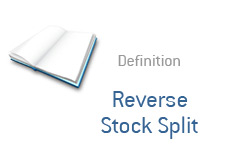Definition of Reverse Stock Split
What is a Reverse Stock Split?
A reverse stock split is when a company reduces the number of their outstanding shares. The value of the shares and the company's earnings per share will rise proportionally after the split.
 For instance: you own 1,000 shares in XYZ, and the current market value of each share is $1.00.
For instance: you own 1,000 shares in XYZ, and the current market value of each share is $1.00. The company announces that it will be executing a 1:2 reverse share split.
This means that instead of 1,000 shares, you will now own 500 shares. However, instead of the market value of each share being $1.00, each share is now worth $2.00. So the value of your stake is the same - you simply own less shares that are now worth more money.
Also, if the company had an annual earnings per share of $1.00, this number would now be $2.00 per share.
Reverse Share Splits Are Normally Bad News.
Why? Companies normally execute reverse share splits in order to retain their listing on the Nasdaq or NYSE. These exchanges have minimum price requirements, and a quick and easy way to maintain compliance is to execute a reverse stock split. A reverse stock split normally indicates that there are a multitude of bad things happening at the company.
Example: ABCD is currently trading at 75 cents per share, and has received a Nasdaq delisting notice.
After waiting a number of months to see if their shares will recover over the $1.00 level, ABCD executives decide upon a reverse share split in order to regain compliance. They announce a 1:10 reverse split, and shares in the company now trade at $7.50 per share, instead of 75 cents.
Note: A large percentage of companies that execute reverse splits will continue trading lower after the split. Keep this in mind - a reverse stock split is normally a very big red flag.
--
Davemanuel.com Articles That Mention Reverse Stock Split:
What is a Reverse Stock Split? And Why Is It Usually a Bad Thing For the Stock?
